Olivier Francon
Solving a Million-Step LLM Task with Zero Errors
Nov 12, 2025Abstract:LLMs have achieved remarkable breakthroughs in reasoning, insights, and tool use, but chaining these abilities into extended processes at the scale of those routinely executed by humans, organizations, and societies has remained out of reach. The models have a persistent error rate that prevents scale-up: for instance, recent experiments in the Towers of Hanoi benchmark domain showed that the process inevitably becomes derailed after at most a few hundred steps. Thus, although LLM research is often still benchmarked on tasks with relatively few dependent logical steps, there is increasing attention on the ability (or inability) of LLMs to perform long range tasks. This paper describes MAKER, the first system that successfully solves a task with over one million LLM steps with zero errors, and, in principle, scales far beyond this level. The approach relies on an extreme decomposition of a task into subtasks, each of which can be tackled by focused microagents. The high level of modularity resulting from the decomposition allows error correction to be applied at each step through an efficient multi-agent voting scheme. This combination of extreme decomposition and error correction makes scaling possible. Thus, the results suggest that instead of relying on continual improvement of current LLMs, massively decomposed agentic processes (MDAPs) may provide a way to efficiently solve problems at the level of organizations and societies.
Leveraging Evolutionary Surrogate-Assisted Prescription in Multi-Objective Chlorination Control Systems
Aug 26, 2025Abstract:This short, written report introduces the idea of Evolutionary Surrogate-Assisted Prescription (ESP) and presents preliminary results on its potential use in training real-world agents as a part of the 1st AI for Drinking Water Chlorination Challenge at IJCAI-2025. This work was done by a team from Project Resilience, an organization interested in bridging AI to real-world problems.
Unlocking the Potential of Global Human Expertise
Oct 31, 2024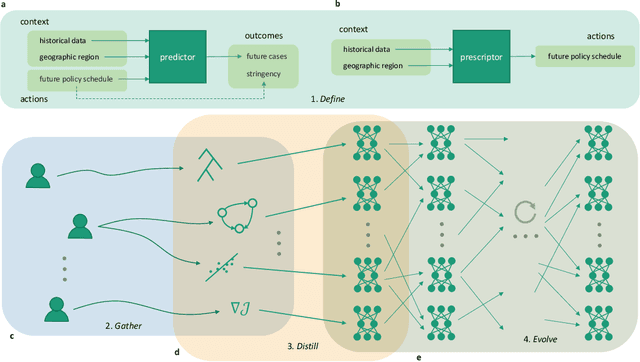
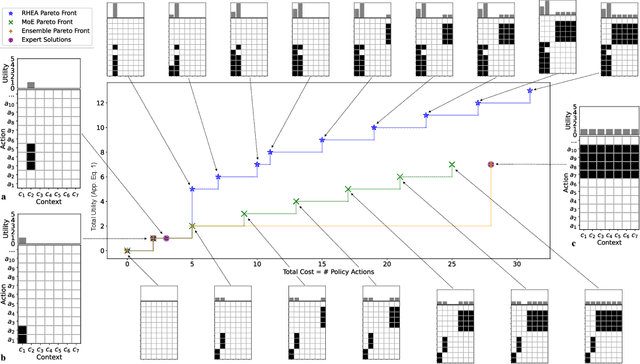
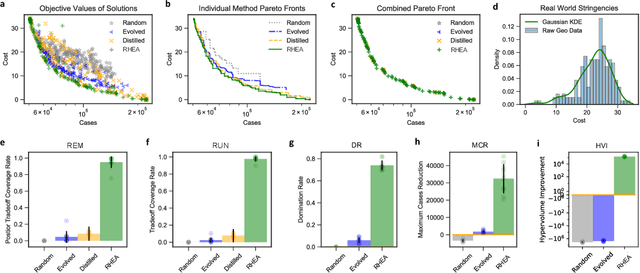
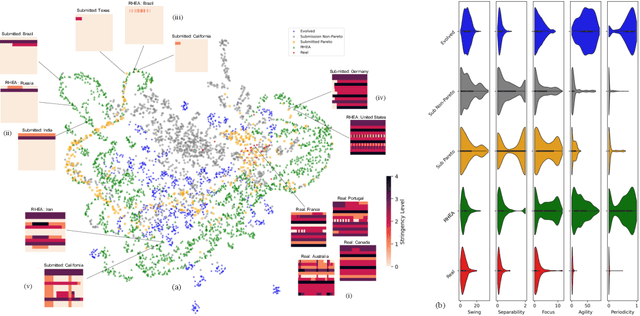
Abstract:Solving societal problems on a global scale requires the collection and processing of ideas and methods from diverse sets of international experts. As the number and diversity of human experts increase, so does the likelihood that elements in this collective knowledge can be combined and refined to discover novel and better solutions. However, it is difficult to identify, combine, and refine complementary information in an increasingly large and diverse knowledge base. This paper argues that artificial intelligence (AI) can play a crucial role in this process. An evolutionary AI framework, termed RHEA, fills this role by distilling knowledge from diverse models created by human experts into equivalent neural networks, which are then recombined and refined in a population-based search. The framework was implemented in a formal synthetic domain, demonstrating that it is transparent and systematic. It was then applied to the results of the XPRIZE Pandemic Response Challenge, in which over 100 teams of experts across 23 countries submitted models based on diverse methodologies to predict COVID-19 cases and suggest non-pharmaceutical intervention policies for 235 nations, states, and regions across the globe. Building upon this expert knowledge, by recombining and refining the 169 resulting policy suggestion models, RHEA discovered a broader and more effective set of policies than either AI or human experts alone, as evaluated based on real-world data. The results thus suggest that AI can play a crucial role in realizing the potential of human expertise in global problem-solving.
Optimizing the Design of an Artificial Pancreas to Improve Diabetes Management
Feb 10, 2024
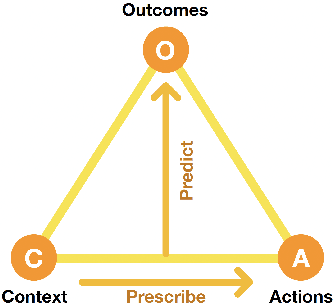

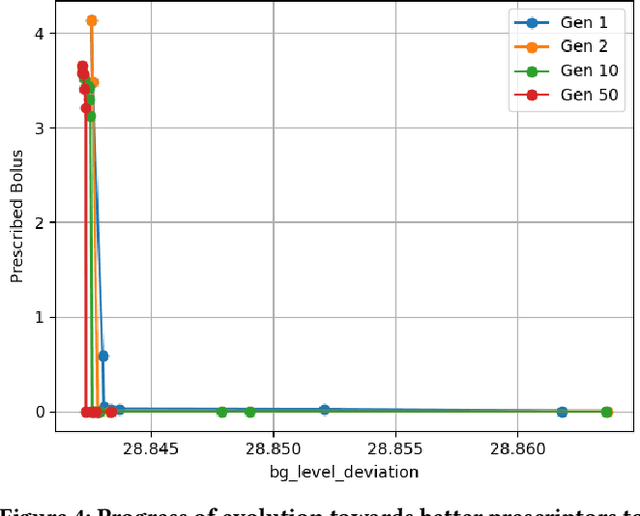
Abstract:Diabetes, a chronic condition that impairs how the body turns food into energy, i.e. blood glucose, affects 38 million people in the US alone. The standard treatment is to supplement carbohydrate intake with an artificial pancreas, i.e. a continuous insulin pump (basal shots), as well as occasional insulin injections (bolus shots). The goal of the treatment is to keep blood glucose at the center of an acceptable range, as measured through a continuous glucose meter. A secondary goal is to minimize injections, which are unpleasant and difficult for some patients to implement. In this study, neuroevolution was used to discover an optimal strategy for the treatment. Based on a dataset of 30 days of treatment and measurements of a single patient, a random forest was first trained to predict future glucose levels. A neural network was then evolved to prescribe carbohydrates, basal pumping levels, and bolus injections. Evolution discovered a Pareto front that reduced deviation from the target and number of injections compared to the original data, thus improving patients' quality of life. To make the system easier to adopt, a language interface was developed with a large language model. Thus, these technologies not only improve patient care but also adoption in a broader population.
Discovering Effective Policies for Land-Use Planning
Nov 21, 2023Abstract:How areas of land are allocated for different uses, such as forests, urban, and agriculture, has a large effect on carbon balance, and therefore climate change. Based on available historical data on changes in land use and a simulation of carbon emissions/absorption, a surrogate model can be learned that makes it possible to evaluate the different options available to decision-makers efficiently. An evolutionary search process can then be used to discover effective land-use policies for specific locations. Such a system was built on the Project Resilience platform and evaluated with the Land-Use Harmonization dataset and the BLUE simulator. It generates Pareto fronts that trade off carbon impact and amount of change customized to different locations, thus providing a potentially useful tool for land-use planning.
From Prediction to Prescription: AI-Based Optimization of Non-Pharmaceutical Interventions for the COVID-19 Pandemic
May 30, 2020
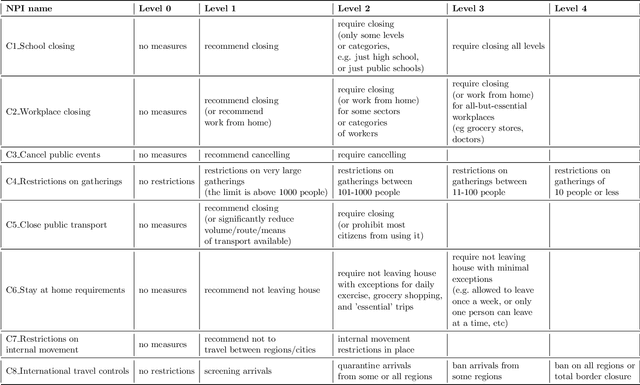
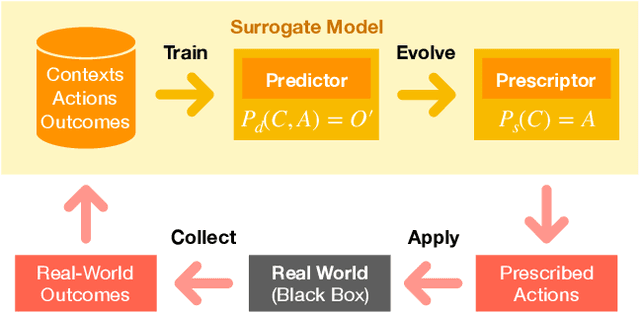

Abstract:Several models have been developed to predict how the COVID-19 pandemic spreads, and how it could be contained with non-pharmaceutical interventions (NPIs) such as social distancing restrictions and school and business closures. This paper demonstrates how evolutionary AI could be used to facilitate the next step, i.e. determining most effective intervention strategies automatically. Through evolutionary surrogate-assisted prescription (ESP), it is possible to generate a large number of candidate strategies and evaluate them with predictive models. In principle, strategies can be customized for different countries and locales, and balance the need to contain the pandemic and the need to minimize their economic impact. While still limited by available data, early experiments suggest that workplace and school restrictions are the most important and need to be designed carefully. It also demonstrates that results of lifting restrictions can be unreliable, and suggests creative ways in which restrictions can be implemented softly, e.g. by alternating them over time. As more data becomes available, the approach can be increasingly useful in dealing with COVID-19 as well as possible future pandemics.
Effective Reinforcement Learning through Evolutionary Surrogate-Assisted Prescription
Feb 13, 2020
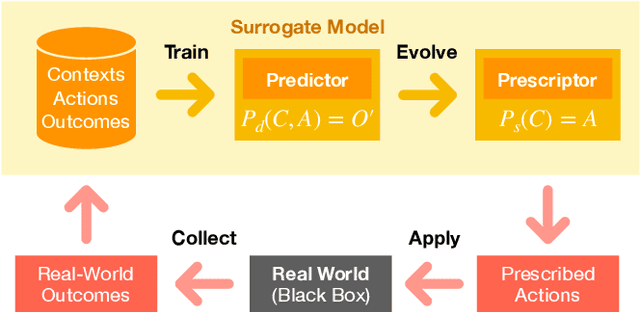

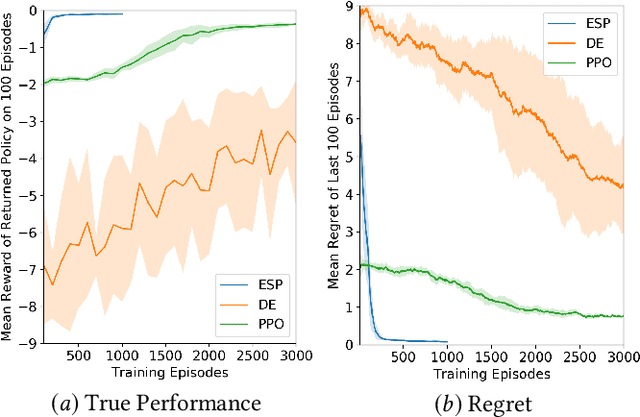
Abstract:There is now significant historical data available on decision making in organizations, consisting of the decision problem, what decisions were made, and how desirable the outcomes were. Using this data, it is possible to learn a surrogate model, and with that model, evolve a decision strategy that optimizes the outcomes. This paper introduces a general such approach, called Evolutionary Surrogate-Assisted Prescription, or ESP. The surrogate is, for example, a random forest or a neural network trained with gradient descent, and the strategy is a neural network that is evolved to maximize the predictions of the surrogate model. ESP is further extended in this paper to sequential decision-making tasks, which makes it possible to evaluate the framework in reinforcement learning (RL) benchmarks. Because the majority of evaluations are done on the surrogate, ESP is more sample efficient, has lower variance, and lower regret than standard RL approaches. Surprisingly, its solutions are also better because both the surrogate and the strategy network regularize the decision-making behavior. ESP thus forms a promising foundation to decision optimization in real-world problems.
Evolving Deep Neural Networks
Mar 04, 2017
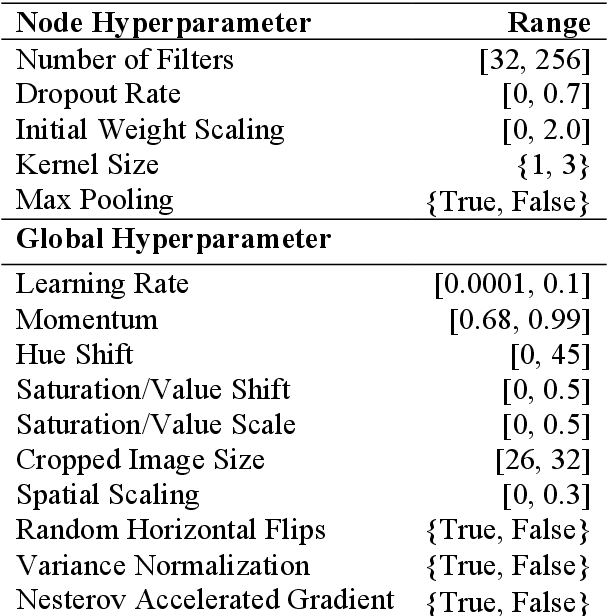
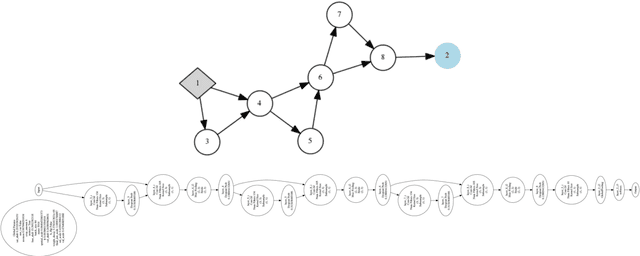
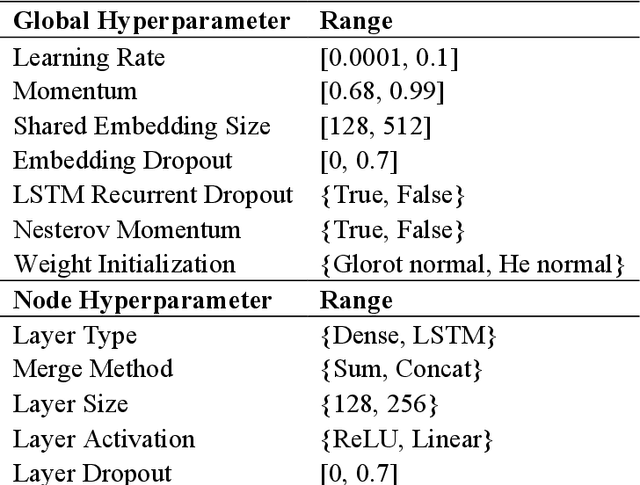
Abstract:The success of deep learning depends on finding an architecture to fit the task. As deep learning has scaled up to more challenging tasks, the architectures have become difficult to design by hand. This paper proposes an automated method, CoDeepNEAT, for optimizing deep learning architectures through evolution. By extending existing neuroevolution methods to topology, components, and hyperparameters, this method achieves results comparable to best human designs in standard benchmarks in object recognition and language modeling. It also supports building a real-world application of automated image captioning on a magazine website. Given the anticipated increases in available computing power, evolution of deep networks is promising approach to constructing deep learning applications in the future.
 Add to Chrome
Add to Chrome Add to Firefox
Add to Firefox Add to Edge
Add to Edge